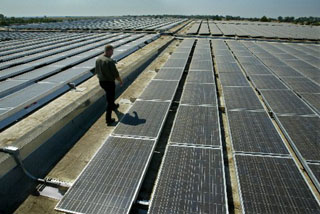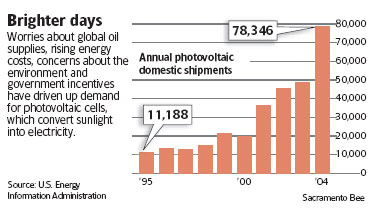
Let it shine, let it shine
August 14, 2006 - Jon Ortiz - Sacramento Bee
 |
| Beneath the solar panels, the
freezer section at Tony's Fine Foods is one cold
place to work. Solar power runs the 140,000-square-foot
distribution center, with power to spare.
-Sacramento Bee/Bryan Patrick |
How's this for irony? A massive West Sacramento cold-storage
warehouse is being powered by one of California's
biggest privately owned solar energy systems. Summer's
long, hot days are a plus for Tony's Fine Foods, where
5,782 photovoltaic panels mounted on the roof and
grounds generate more than enough energy to run the
company's 140,000 square-foot chilly distribution
center on Reed Avenue.
The $7 million system, which cost about $3.5 million
after Pacific Gas and Electric rebates, is roughly
the size of three football fields and generates enough
electricity to power 850 homes.
"We figure it will save us an average of $22,000
per month on our utility bill," said Scot Berger,
the company's owner and chief financial officer. "But
beyond the savings, it's something that we're proud
to own."
Tony's, which delivers meat, baked goods and other
perishables to grocery stores and restaurants all
over the West Coast, is on the leading edge of a small
but growing number of companies plugging into solar
power as a way to hedge their bets against fluctuating
utility costs.
 |
| Scot Berger of Tony's Fine Foods
in West Sacramento checks out the massive photovoltaic
system on the warehouse roof. The system is roughly
the size of three football fields and generates
enough electricity to power 850 homes. -Sacramento
Bee/Bryan Patrick |
To achieve that, Tony's roof and part of a nearby
field are filled with black 3-foot by 5-foot panels
that look like gigantic blank dominoes, angled to
maximize their exposure to the sun.
The setup doesn't have storage batteries, so when
the sun isn't out, the facility draws power from the
local grid.
Solar energy makes up a tiny segment of California's
energy portfolio, accounting for about one-quarter
of 1 percent of the state's total electric consumption.
Still, it is one of the state's fastest growing power
generation segments. The Sacramento Municipal Utility
District figures that the industry statewide will
grow 30 percent to 40 percent each year for the foreseeable
future.
"We've received quite a bit of interest in our service
area," said John Bertelino, head of SMUD's renewable
generation division. "We're working on something with
the Los Rios (Community College) district. Government
agencies, private businesses are interested, too,
everyone from the state Department of General Services
to Ace Hardware and mom-and-pop gas stations."
Rising fuel prices, global warming worries and changes
in world events that have spooked oil markets are
prodding companies to think about solar, Bertelino
said.

Mix in federal tax credits and subsidies that bring
down the cost of installing solar systems by 50 percent
or more, and what was once considered a costly fringe
technology starts to look like a sound business move.
Some companies tapping into solar power include:
• Microsoft Corp., which in April activated a 480-kilowatt
system at its Mountain View campus.
• Fetzer Vineyards, which started construction last
month on a 901-kilowatt array to be finished by October
at its Hopland bottling plant.
• Wholesale distributor Coastal Pacific Foods, which
powered up a 723-kilowatt system at its Ontario center.
Tony's executives started looking into solar power
two years ago and contracted Solar Development Inc.
of Roseville last summer to design and install a system.
Japan-based Sharp Electronics Corp. made the cells
in Japan and assembled them into panels at its Memphis,
Tenn., plant. The finished product was then shipped
in nine tractor trailers to West Sacramento.
Solar Development's subcontractors took seven months
to install the solar array, converters and wiring.
The system uses aluminum and stainless steel fasteners
and has no moving parts, so it needs little maintenance
other than occasionally hosing down the panels to
keep them operating at peak efficiency.
Experts say well-made photovoltaic systems last 25
years or more before their capacity to convert sunlight
starts to appreciably degrade.
Tony's flipped the switch in May, activating the
largest solar plant in a commercial business in California,
"and quite possibly the nation," said Kevin Davies,
Solar Development's project manager. "It's certainly
among the biggest, that's certain."
The electricity generated powers Tony's offices,
charges the batteries for 40 pallet movers and 20
electric forklifts, chills its warehouse to 34 degrees
and frosts its 38,000-square-foot frozen food section
to 10 degrees below zero.
Even with all of that, the system still produces
more electricity than Tony's uses. On sunny days the
company's meter runs backwards as the excess automatically
flows into the grid.
"We figure that our cost savings will pay for the
system within seven years," Berger said. "When we
added everything up, it was a no-brainer."

|